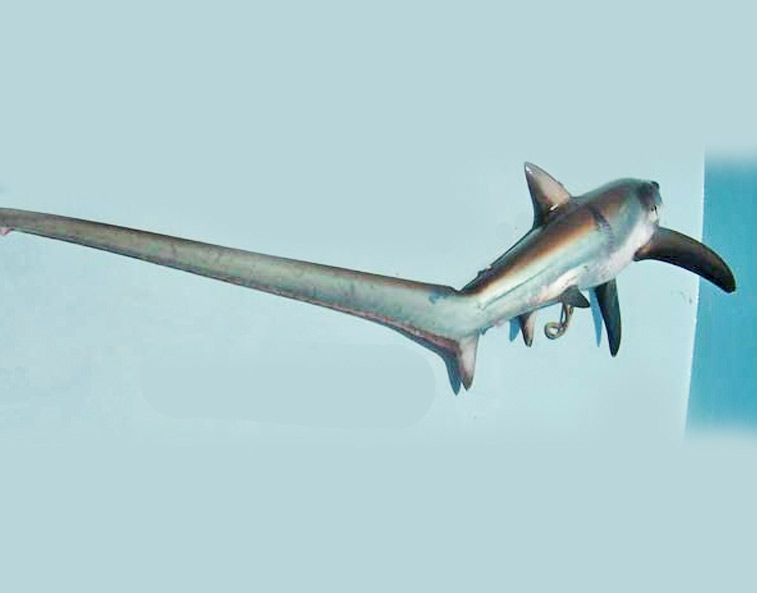Thresher Shark

(Alopias vulpinus)
There are actually two species of thresher shark anglers might encounter along the East Coast and Gulf of Mexico, they include the common thresher (Alopias vulpinus) and the bigeye thresher (Alopias superciliosus). Of the two, the bigeye is seldom taken by recreational anglers as it's apparently not as abundant and it frequents the deeper waters beyond the Continental Shelf. However, the common thresher is a shark encountered regularly by fishermen in the Mid-Atlantic and Northeast and occasionally in the south.
It's tough to imagine a better shark to suit the needs of recreational anglers than the common thresher. Threshers will put up as powerful and exciting a fight as any of the other sharks, including long runs, jumps, and a variety of other tactics that will keep fishermen in awe. Depending upon the location, time of year, and availability of bait, threshers might be found anywhere from the surf-line all the way out to the 100 fathom line. And even though threshers will grow to over 700 pounds, smaller animals are encountered frequently enough that they can also provide anglers with excellent light-tackle opportunities.
You don't have to be a shark expert to take one look at a thresher and realize that it's unique among sharks. The colors are a stunning combination of blue, purple, silver, and white, and the top lobe of the thresher's tail is as long as the entire body of the fish itself. But the tail is not just designed for propulsion, it's an effective tool used to whack and stun the small schooling fish these sharks primarily feed on. An inspection of the other end of this fish reveals a very small mouth with tiny teeth clearly indicating that, despite their potentially large size, threshers are designed to feed on very small prey.
We've hooked threshers on surface baits presented under kites, on float baits, and in the mid-range, but most of our thresher bites typically come on baits fished close to the bottom. But anglers should know that just because they hook a thresher on the bottom doesn't mean that they won't be seeing the shark up on the surface very soon. It's not uncommon for these sharks to pick up a deep bait, and before the hook is even set come racing to the surface and jump. Needless to say, such actions can surprise a crew and cause more than just a little commotion on deck.
In recent years it has come to attention that many if not most of the large female thresher sharks taken in the Mid-Atlantic region in late May and early June are gravid (pregnant) with four to six very well developed pups. With so much still unknown about the biology of threshers, and the health and future of their populations, one can only assume that harvesting gravid females cold have catastrophic results on the future of this species. By adopting a policy to release all female threshers caught before July 1st anglers will at least give these incredible sharks a better chance to deliver their pups and perpetuate their species.




 Email Article
Email Article 




